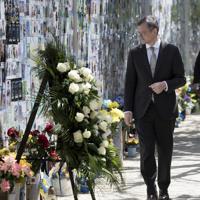


Russia said Wednesday its forces had pushed deeper into the Kharkiv region and also captured the symbolic town of Robotyne further south, one of the only prizes of Ukraine‘s underwhelming counteroffensive last summer.
Moscow’s claims came as U.S. Secretary of State Antony Blinken announced fresh military aid while in Kiev and said Washington had not explicitly prohibited Ukraine from using Western weapons to strike targets inside Russia.
Moscow’s advances on two fronts point to the acute ammunition and manpower shortages crippling the Ukrainian military and paving the way for the Kremlin’s army to eat away at Ukrainian territory.
President Volodymyr Zelensky cancelled planned trips abroad over the fresh offensive and the military was sending more troops to Kharkiv to hold back Russian advances, Kiev said.
“Units of the North group of troops liberated the settlements of Glyboke and Lukyantsi in Kharkiv region and also advanced deep into the enemy defences,” the Russian defense ministry said, announcing their latest gains.
The defense ministry also said it had captured the southern Ukrainian village of Robotyne, one of only a handful of settlements Kiev retook at a huge cost in its summer counteroffensive last year.
Zelensky had visited the village in February and had hailed its recapture as a major success in what had otherwise been an operation plagued with setbacks.
‘Extremely difficult’ fighting
Moscow launched a surprise major ground assault on the Kharkiv region last week as it seeks to advance across the battlefield with Kiev struggling for arms and manpower.
The Russian advances have forced the evacuation of around 8,000 civilians from the Kharkiv region under risk of being caught in the crossfire, Ukrainian emergency services said.
A military spokesman conceded earlier on Wednesday on state television that Kiev had withdrawn troops — including near Lukyantsi — citing overwhelming Russian onslaughts and the need to save soldiers’ lives.
Authorities in another village under attack, Vovchansk, said there was intense street-to-street fighting in the border town that before the war had an estimated population of 20,000 people.
“We are here and are evacuating people and helping them. The situation in Vovchansk is extremely difficult,” police chief Oleksiy Kharkivsky said on social media.
The interior ministry announced that three civilians had been killed in the Kharkiv region over the last 24 hours and the national police said five civilians had been wounded by Russian fire on Wednesday.
At least two people were killed in Russian aerial attacks on the city of Dnipro, local authorities said.
Zelensky’s office said the president had postponed upcoming trips and reiterated that the military was rushing reinforcements to the area to prevent Russia from punching through.
“Additional forces are being deployed, and there are reserves,” Zelensky’s office said.
He had been planning to visit Spain later this week.
‘Difficult’ fighting in east
Some military analysts say Moscow may be trying to force Ukraine to divert troops from other areas of the front line, such as around the strategic town of Chasiv Yar in the Donetsk region, where Russia has also been advancing.
“Donetsk and Kharkiv regions are where it is most difficult now,” Zelensky said in an address on Tuesday evening.
Blinken’s visit came just weeks after the U.S. Congress finally approved a $61-billion financial aid package for Ukraine following months of political wrangling, unlocking much-needed arms for the country’s outgunned troops.
Washington’s top diplomat said the United States was releasing $2 billion from the major aid package.
He also appeared to tacitly green-light Ukrainian strikes with Western weapons on Russian territory.
“We have not encouraged or enabled strikes outside of Ukraine, but ultimately Ukraine has to make decisions for itself about how it’s going to conduct this war,” Blinken said.
Some Ukrainians reacted angrily to Blinken’s guitar performance in a bar in Kiev late Tuesday, chastising Washington’s top diplomat for an ill-judged jam session while troops are fighting in trenches, struggling to hold back a Russian advance amid a shortage of weapons.
Ukrainian officials have said that more than 30,000 Russian forces have been deployed to the northeastern region but that the main hub of Kharkiv, the country’s second-largest city, was not threatened by the offensive.
Ukraine also launched aerial attacks on Russia, forcing the closure of two airports in the region of Tatarstan, some 1,000 kilometers (620 miles) inside Russian territory.
Russian aerial defense systems intercepted and destroyed 17 drones across several border areas, as well as 10 ATACMS missiles over the annexed Crimean peninsula, the defense ministry said.